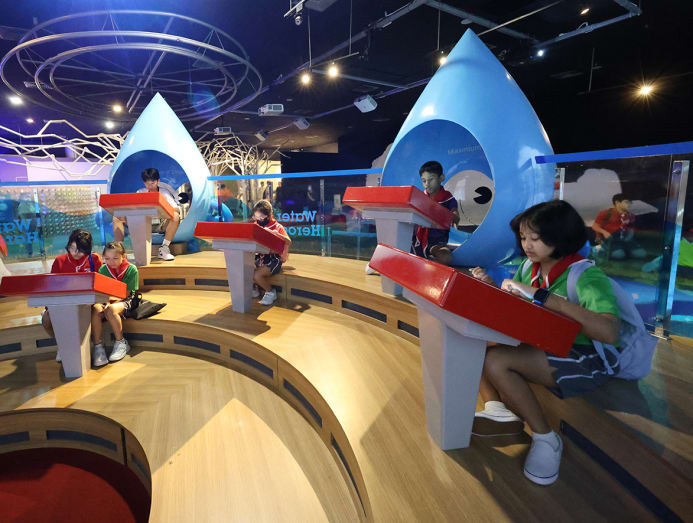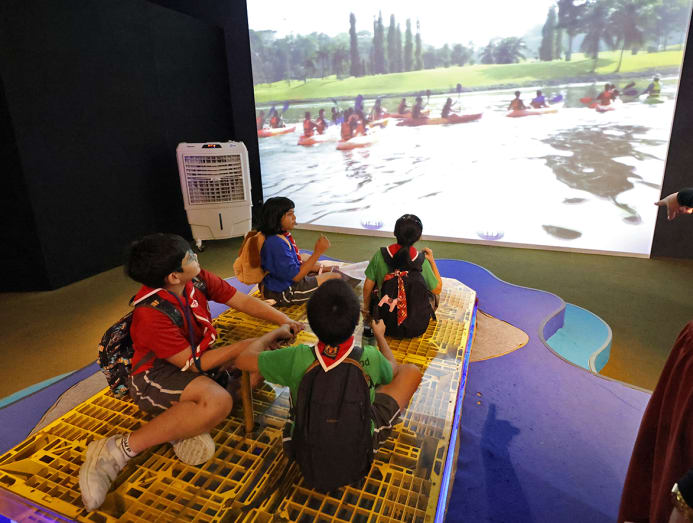I toured the NEWater visitor centre as a kid. Saying goodbye to it now brings back a flood of memories

Journalist Nikki Yeo at the NEWater Visitor Centre on July 2, 2024.
SINGAPORE — Upon hearing that the NEWater Visitor Centre in Bedok was set to close by the end of the month, I suddenly felt nostalgic and sad for a place that I've largely forgotten about since my visit as a primary school pupil.
Despite being a stone's throw away from my home, I confess that I never really paid heed to its existence since my trip some 20 odd years ago, let alone considered visiting it again.
However, the news did bring back a torrent of memories to a time when I was a child growing up in Bedok and having the NEWater visitor centre as an excursion destination.
I remember walking home and peering into the long lane that leads to the factory that spans six hectares, which is the size of around 11 football fields, and wondering what was going on within it.
Most of all, I remember receiving a bottle of recycled water after the tour ended and joking with my classmates at the time about its taste.
Located at 20 Koh Sek Lim Road, the visitor centre first opened in 2003 and has offered free one-hour-long guided tours on Tuesdays to Sundays.
The centre, which sees an average of 5,000 visitors a month, has welcomed a total of 1.7 million visitors since its inception.
Last month, national water agency PUB announced that the visitor centre and its adjacent Bedok NEWater factory will be shuttered on July 31 because the factory had reached the end of its "operational lifespan".
The factory will be replaced with a third NEWater factory at Changi Water Reclamation Plant, which will be more than double the Bedok factory's production capacity.
It was not clear if there will be a replacement visitor centre elsewhere, but PUB has said that it would "look into leveraging other sites" to develop the "next iteration of NEWater education".
So, I quickly signed up for one of the final guided tours at the centre before its closure.
Apparently, I wasn't alone. All remaining tour dates had been fully booked right after the news broke.
Thankfully, I was able to snag a spot as part of a work assignment to experience (again) what the tour is about before it is forever consigned to history.
I was excited, of course, but I was still fully expecting to sit through lengthy lectures on the technical details of the water filtration process and to be surrounded by the constant messaging of Singapore's water needs.
Little did I know that I would be learning new things about the age-old topic of water security with a fresh pair of eyes while taking a personal trip down memory lane.

WATER WALLY, GAMES, AND MORE
My tour was set on July 2 and it turned out that I was one of the few adults on an interactive tour with a group of Primary 4 and 5 pupils from Greenwood Primary School there to earn their “water conservation” badge for their Scouts co-curricular activity.
Also present was a tour group of high school students from Taiwan. Clearly, interest in NEWater goes beyond our shores.
Surrounded by these young folk, the tour experience was just like it was back in my schooling days — being an excited kid competing with my classmates to collect rainwater and to simulate the journey of a water molecule wiggling through filtration membranes.
One game that stood out was called Water Heroes, in which I became a virtual avatar and was tasked to catch water droplets from the sky and avoid obstacles such as fishbones.
For me, though, the most memorable part of the guided tour came at the beginning, during a screening of a video titled Waters of Singapore, which explained the country's four "national taps" — including catchment water, imported water and NEWater — and the process of treating reclaimed water.
It was then time for a quick quiz.
Our guide began asking water-related questions such as the total number of reservoirs in Singapore.
When the guide asked about the two main existential challenges that the island-state faces today, my mind started racing through countless possibilities.
However, I was too slow because two children enthusiastically provided the right answer: Water and land scarcity.
In that moment, I was struck by the simplicity and confidence of their responses and realised that over time, I tended to overcomplicate matters instead of going back to the basics.

OLD FACTORY, NEW WATER FACTS
While the interactive games were quickly taken over by eager pupils, I lingered around a section marked as Water Pavilion, where an arrangement of pipes invited visitors to peer into them to discover tips on conserving water.
As I explored the section, I rediscovered facts that I didn't commit to memory. Did you know that 60 per cent of an average adult is made up of water?
There was also information that struck a more sobering note, such as one billion people around the world having to walk 6km a day to get water and a quarter of the world’s population not having clean drinking water.
I realised I was seeing things anew, that this wasn't a visitor centre meant only for schoolchildren but also for adults to immerse themselves in a learning environment again.
Unlike my fellow younger visitors who rushed quickly between the exhibits, I was spellbound by the developments of Singapore's deep tunnel sewerage system, an “underground superhighway” that is 206km long and conveys used water via gravity to water reclamation plants across the island.
I also learnt new facts about how the bulk of NEWater is used for industrial purposes. Consumers only get a taste of NEWater after it is indirectly channelled through the island's reservoirs during dry spells, and it is treated before being delivered as tap water.
I didn't forget everything from my trip from two decades ago, thankfully. One section that I still remembered seeing was the factory’s water filtration system that was kept behind expansive glass windows.
Microfiltration, reverse osmosis and ultraviolet disinfection — these were the three stages of NEWater production that were somehow etched in my memory.

THE CHARM OF VISITOR CENTRES
With all that I learnt and re-learnt that day, I couldn't help but wonder what Singapore would be losing from the closure of this public facility that has quietly served a national education purpose all these years.
Apart from serving students, the NEWater Visitor Centre was a stop on a tour for new citizens organised by tour operator Lion Heartlanders to enrich the new citizens’ understanding of the key milestones in Singapore’s history.
I was later relieved that I wasn't alone in feeling this sense of nostalgia and loss.
Speaking to the teachers accompanying the group of pupils, I heard tales of their own visits to the NEWater facility back in their schooling days.
There was Madam Nazeera Sulaimi, 35, who teaches English and mathematics at Greenwood Primary School, who told me that she fondly recalls pretending to be a molecule undergoing the water filtration process.
Returning as a teacher, she was surprised that students were attentive and enthusiastically answering the guide’s questions.
"They really enjoyed learning something that’s beyond the textbook, to hear and see the technology in action,” Mdm Nazeera told me.
Agreeing, Ms Cynthia Ang, 28, who teaches Chinese language, said that the visitor centre was a helpful place to educate the public on how NEWater is made and she is hoping that a new centre would be set up elsewhere.
While many exhibits were familiar, we all lamented that we weren’t given a bottle of NEWater during the tour, which we remembered fondly from our first visits.
As for what the students had to say about the experience, 11-year-old student Muhammad Waqiyyuddin Haziq Zainuddin told me that before the tour, he had known only that NEWater “came from urine”.
However, he had been convinced of NEWater’s cleanliness after learning about the third step of ultraviolet disinfection, even though the water is already clean after the second step of reverse osmosis.
His answer made me realise that many years from now, he might not get the same chance to revisit this place and to truly realise how challenging but necessary it is for Singapore to recycle each drop of water.


I know that the closure of the visitor centre might not turn on the waterworks for many people as it did for me, by virtue of the fact that I lived next to the NEWater factory.
Indeed, my family and friends didn't think much of the news of the impending closure — though my mum did express regret that she will not be able to visit it once before its doors shut permanently.
But to me, this visitor centre was an important place that found a way to transform complex issues of Singapore's vulnerabilities into an enjoyable and hands-on experience, as evident from the smiles from the kids' faces.
I hope that the spirit of this visitor centre will not be lost with its closure, so that the generations to come will have the opportunity to explore and learn in a similarly engaging environment.








